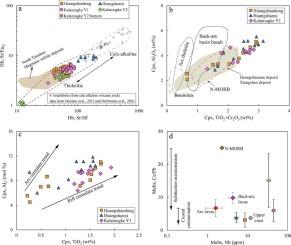Mafic mineral chemistry as an insight into magma characteristics, tectonic settings and mineralization in three magmatic Ni-Cu deposits in North Xinjiang, NW China
IF 3.6
2区 地球科学
Q1 GEOLOGY
引用次数: 0
Abstract
This study utilizes detailed mineral chemistry of mafic phases (clinopyroxene, hornblende, olivine, Cr-spinel) from the Huangshandong (HSD), Huangshanxi (HSX), and Kalatongke Ni-Cu sulfide deposits in the Central Asian Orogenic Belt to elucidate magma characteristics, tectonic settings, and key factors of mineralization. Crystallization conditions (1174–1234 °C; <400 MPa) suggest rapid magma emplacement and imply that regional strike-slip structures facilitated efficient magma ascent and promoted mineralization. The primary magmas were high-Mg tholeiitic melts with moderate H2O contents (<2.6 wt%), as indicated by: equilibrium melt compositions constrained by Cr-spinel chemistry; trace-element ratios in hornblende (e.g., Sr/Hf<200); and clinopyroxene hygrometry combined with compositional discrimination. Cr-spinel compositions (Cr#=41–64) and clinopyroxene chemical trends (rift-cumulate) reflect a non-arc, post-subduction extensional setting associated with asthenosphere upwelling triggered by slab detachment. The melts in equilibrium with orthopyroxene exhibit LREE enrichment signatures, indicating derivation from subduction-metasomatized lithosphere mantle. The enrichment of U and Pb in the melt equilibrium with hornblende confirms the incorporation of crustal material into the magma source, consistent with metasomatized mantle characteristics. The magma source comprises upwelling asthenosphere mantle and metasomatized mantle. Lower Ce/Pb ratios in the melts relative to arc and back-arc lavas suggest upper crustal contamination. Crustal contamination plays a key role in sulfide saturation.

基性矿物化学对新疆北部3个岩浆型镍铜矿床岩浆特征、构造环境和成矿作用的认识
本文利用中亚造山带黄山东(HSD)、黄山(HSX)和卡拉通克镍铜硫化物矿床基性相(斜辉石、角闪石、橄榄石、铬尖晶石)的详细矿物化学资料,阐明了岩浆特征、构造背景和成矿关键因素。结晶条件(1174 ~ 1234℃;<400 MPa)表明岩浆侵位迅速,表明区域走滑构造有利于岩浆的有效上升,促进了成矿作用。原生岩浆为高镁拉斑岩熔体,H2O含量适中(<2.6 wt%),表明:熔体平衡成分受cr -尖晶石化学约束;角闪石中微量元素比值(如Sr/Hf<;200);并结合斜辉湿法进行成分判别。Cr-尖晶石组成(Cr#= 41-64)和斜辉石化学趋势(裂谷-堆积)反映了一个非弧形的俯冲后伸展环境,与板块脱离引发的软流圈上升流有关。与正辉石平衡的熔体表现出LREE富集特征,表明其来源于俯冲交代岩石圈地幔。角闪石熔体平衡中U、Pb富集,证实了地壳物质进入岩浆源,符合交代地幔特征。岩浆源包括上涌软流圈地幔和交代地幔。相对于弧和弧后熔岩,熔体中Ce/Pb比值较低,表明上部地壳受到污染。地壳污染在硫化物饱和中起关键作用。
本文章由计算机程序翻译,如有差异,请以英文原文为准。
求助全文
约1分钟内获得全文
求助全文
来源期刊

Ore Geology Reviews
地学-地质学
CiteScore
6.50
自引率
27.30%
发文量
546
审稿时长
22.9 weeks
期刊介绍:
Ore Geology Reviews aims to familiarize all earth scientists with recent advances in a number of interconnected disciplines related to the study of, and search for, ore deposits. The reviews range from brief to longer contributions, but the journal preferentially publishes manuscripts that fill the niche between the commonly shorter journal articles and the comprehensive book coverages, and thus has a special appeal to many authors and readers.
 求助内容:
求助内容: 应助结果提醒方式:
应助结果提醒方式:


